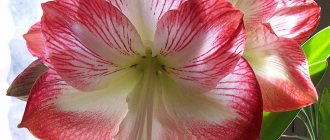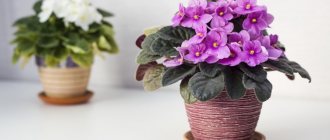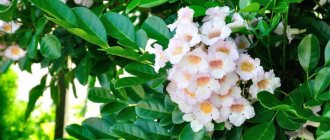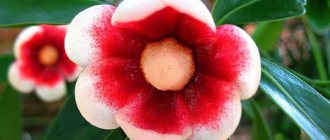Useful tips
Primrose Flower
always takes first place among lovers of home flowers.
Primrose is
completely unpretentious. Its color range is distinguished by a very wide spectrum and a unique charm.
Primrose
begins to bloom very early, almost immediately after the snow melts. That's why it got its name, which means first.
This flower
It can be perennial or annual. Some types of perennials are grown in open ground as annuals. This is done due to frost. When planting flowers at home in pots, they can not only live for a long time, but also delight their owners with beautiful blooms in early spring and winter.
Features of primrose transplantation
Primrose after purchase
You should definitely replant the plant after purchasing it, but do not rush to start the procedure immediately. Primrose must adapt to new conditions and not immediately face a stressful procedure.
Indoor primrose sold in stores is subject to special processing to maintain its presentation . Once in a new space, it must adapt within 7 days, after which the flower can be replanted. As soon as the adaptation period approaches completion, make sure you have a soil mixture intended for planting and a pot that will be 3 cm larger than the original one.
Container for transplanting primrose
To transplant indoor primrose, you can choose a container with drainage holes at the bottom. This can be a plastic container or clay. It is advisable that the container has a tray, which will allow the remaining water to be drained without allowing the root system to rot. When an indoor primrose is transplanted after purchase, in the last days of adaptation, watering should be reduced, but not stopped. Using the transshipment technique, it will be much easier to move the flower to a new “house”.
Types of home primrose with photos and names
The genus includes about 500 plant species. Only a few of them are grown indoors.
Primula obconica or obconical (Primula obconica)
Tall (up to 60 cm) herbaceous perennial with a lush rosette of long-petioled large (length 10 cm) rough leaves, heart-shaped, with a wavy edge. It blooms, forming umbrella-shaped inflorescences of buds of various colors with a diameter of 3-4 cm, emitting a subtle pleasant aroma.
Primula malacoides or mallow-like (Primula malacoides)
An annual herbaceous plant up to 40-45 cm high with a dense elastic rosette of elongated oval leaves with a serrated edge. It begins to bloom in late autumn, forming up to 8 tall peduncles on one plant, ending in whorls of tiered inflorescences, consisting of several dozen (up to 45) small (diameter up to 1.5 cm) buds of pink, red or white shades, often interspersed with streaks, yellow core.
Common primrose or stemless (Primula vulgaris)
It is represented by a large number of hybrids with a dense rosette of elongated oval wrinkled leaves, in the central part of which the pinnate venation is clearly visible. It blooms in early spring, 3-4 weeks, forming low peduncles ending in single large (2-4 cm) buds of snow-white, blue-lilac, red, yellow and burgundy shades. This species is offered for sale more often than others and is cultivated both in pots and in open ground.
Important rules for replanting after purchase
When purchasing a flowering plant, you should remember that replanting is possible only when it fades. This rule should be observed not only in relation to perennial primrose, but also to other plant species.
When moving to another pot, it is necessary to add a nutrient substrate, but it is important not to overfeed.
Preparing soil mixture for replanting
As a base for the substrate, you can choose peat, sand, and compost in a ratio of 1/1/3. You can select components such as sand, turf, leafy soil, as well as coniferous soil in a combination of 1/1/1/2 (suitable for soft-leaved soil). There are other options that are specially created and designed to be placed in a pot when transplanting primrose.
Primrose transplantation
When replanting a flower, you should do the following:
- Place a drainage layer (approximately 2 cm) on the bottom of the container and level it.
- Lay the soil mixture (almost all of it, but leave some), making a depression in the central part.
- Transfer the flower from the previous pot to a new mixture.
- Sprinkle the edges with the rest of the substrate. Compact the soil, leaving about 0.5 cm to the edges of the pot.
When changing containers, it is very important to evenly distribute the mixture in it. When the pot is completely filled, it must be compacted, and if voids form, add additional soil composition. These rules should be followed no matter what type of plant is being transplanted, perennial primrose, or any other species.
After the transplant is completed, it is necessary to moisten the substrate . The remaining liquid formed in the lower part will need to be drained. After watering, the soil mixture may sag slightly. If compaction occurs by 0.5 cm or more, it is necessary to add the mixture.
Having moved the flower after purchase to a new container with fresh soil, you can safely place it on the windowsill. The plant does not need to be disturbed for several weeks. You should be given time to adapt at home, so you need to choose a place where he will be comfortable throughout the entire period of adaptation. Do not forget that pets and children should not come into contact with the sheets, as this will lead to irritation or dermatitis.
Primula Mix
When choosing a placement area, it is important to take into account that Primrose Mix, like other varieties, needs an area that is not exposed to direct sunlight. Lighting should be as diffused as possible. It is necessary to water a flower in a new pot when the soil dries out. It is better to fertilize after at least 1.5, maximum 2 weeks, applying fertilizer regularly.
Advice: If you want caring for primrose at home to give good results, choose a flowering version that does not have gray mold (even in the area of undeveloped buds, under the leaves, etc.). Also, the flower should not have dried areas.
Primrose propagation
At home, primrose is propagated in several ways. Let's consider propagation by dividing the bush, seeds and cuttings.
Dividing a primrose bush
The simplest and highest quality way is to propagate primrose by dividing the bush. We recommend using a three or, better yet, four year old plant for this. Keep in mind that you can divide the bush only after the end of its flowering period, somewhere in a week or two. Remove the flower from the pot, shake off the soil from the roots and carefully divide the plant into separate parts with its growth bud. Sprinkle the sections with ash or crushed coal. Immediately plant the parts of the primrose at some distance from each other in a low container, cover with glass or film and grow for some time in a bright place. Water thoroughly. After a couple of weeks, transplant the bushes into separate pots and care for them as you would for adult plants.
Propagation by seeds
If you choose this method of propagating primrose by seeds, keep in mind that it is more troublesome and time-consuming. Seeds can be planted both in summer and in November-December. We recommend planting them in summer. Use any containers for sowing - wide, shallow pots or containers. Fill them with loose substrate and moisten it. Distribute the seeds evenly over the surface and lightly sprinkle them with soil. Cover the plantings with film or a lid. Place the greenhouse in a cool place from 16 to 20 degrees. If necessary, moisten the soil and ventilate the seedlings.
This may be interesting: Why anthurium (male happiness) does not bloom
The sprouts will appear in 15 - 20 days. After a couple of months, divide the dense seedlings and transplant them into separate pots. They need diffused light, moderate watering and protection from sunlight and drafts. Primrose prefers low temperatures, up to 15 degrees. In autumn, pots should be placed in cool but bright rooms. With proper care, young primroses may well bloom by the New Year.
Reproduction by cuttings
If your primrose has only one rosette of leaves or a weak root system, and there is no way to divide the bush into parts, you will have to master the method of propagating primrose by cuttings.
From the mother bush at the base of the root collar, use a sharp knife to separate a primrose leaf with a petiole and a growth bud. Cut off the top half of the leaf. Plant the cutting in a container with peat. Sprinkle some river sand on top. Moisten the substrate. Close the container lid. Place in a bright, warm place (16 - 18 degrees) for rooting. Regularly moisten the soil and ventilate the greenhouse. Be patient - rooting lasts 3 - 4 months. When roots and small leaves appear, the seedling can be transplanted into a permanent small pot with soil normal for primrose. Your primrose will bloom no earlier than in 6 - 7 months.
More details about choosing a pot
A pot for planting a flower at home should have a relatively shallow depth, while being quite wide. The plant is endowed with a fibrous, rather voluminous rhizome system, and needs a sufficient amount of free space.
A container intended for Primrose Mix or other types must be made of any material other than metal and glass. Such textures are cold. They are able to cool quickly and cool the root system of the plant.
What does primrose look like?
Primrose flower is a herbaceous perennial plant belonging to the Primrose family. The leaves are colored in shades of gray-green, often monochromatic. They have the shape of an elongated oval, which tapers downwards. Depending on the variety, the edges of the leaves are smooth or jagged, the surface is smooth or embossed. The leaves are covered with fine hair, soft and slightly fluffy to the touch.
The height of the flowering stem usually does not exceed 25-50 cm; a bunch of leaves grows at its base, which is placed on top of the soil. At the top of the peduncle there is an umbrella-shaped inflorescence, which consists of a group of flowers. There are varieties with a short stem and single flowers. Flowers can be colored yellow, purple, white and red, also in shades of pink and lilac. The petals can be plain or variegated, the core of the flower is often yellow.
Pink flowers
Note! Primrose is not only an ornamental plant, its leaves can be eaten. They contain a large amount of vitamins and carotene. Primrose leaves contain more ascorbic acid than lemon. The leaves are suitable for making salads and are added to soups and stews.
Full size flower
Is it worth purchasing a ready-made mixture?
Ready-made soil mixture
This flower can be planted in purchased ready-made soil. But it is advisable to create a high-quality composition yourself. To do this, you should take humus, clean coarse sand and peat. Turf soil is also added to these components. This composition is loose, yet moderately nutritious and water-permeable.
Potassium permanganate solution
When replanting primrose at home, it is important to disinfect the soil, since these plants are susceptible to many fungal diseases. Carrying out the disinfection procedure is not at all difficult; for this you need:
- Place the prepared mixture in a thick plastic bag;
- put the mixture in the freezer;
- stand for at least 3 days;
- remove the cured soil from the freezer and let it thaw;
- prepare a strong solution of manganese and pour it onto the mixture while hot;
- after a 12-hour period, the composition should be calcined in the oven at a temperature of +100 degrees Celsius;
- The prepared soil can be placed in a pot.
Further care for primrose at home is not difficult. The main task is to carry out competent planting, the main part of which is the creation of drainage. It should be remembered that for primrose it is important that excess liquid disappears as quickly as possible. Otherwise, the roots of the plant will begin to suffocate and rot.
Propagation by seeds
Homemade primrose is propagated in 3 ways: seeds, division, cuttings. It takes at least 6 months from planting to flowering. Propagation by seeds is a popular method, which is usually used for annual varieties. Planting occurs at different times: in mid-late spring or early summer.
A mixture of deciduous soil and sand (equal amounts) is required. Seeds are collected annually from faded primroses or purchased. They need to be scattered on the surface, watered and covered with glass to provide a greenhouse effect. Then the container should be placed in a cool and bright place for 1.5 - 2 weeks.
After the first shoots appear, the glass is removed, but it is preferable to keep the container at a low temperature. Watering the sprouts should be done once a month; as they grow, the planting should be thinned out. After 3 months, strong species are planted in separate small pots. After growing, replanting into larger containers is required.
Primrose care. We provide the necessary air humidity
Air humidification
The level of humidity is also a significant factor for such a plant, including the Acaulis primrose. If you pay attention to the features of the natural vegetation cycle, you can understand a lot. Early spring, when there is no precipitation and air humidity increases due to snow melting, sufficient coolness and humidity are observed. It is during this period that the plant begins to bloom. This suggests that when caring for primrose, similar conditions should be created.
If everything is clear about ensuring coolness, then how can you ensure a sufficient level of humidity on the windowsill? One answer suggests itself - spray the plant. But such a procedure should not be carried out. Primula Akaulis and other varieties have fibers on the leaves, so drops of water will leave stains.
To ensure proper humidity, you can:
- spray the air around the flower with water at room temperature;
- place a container of water near the pot with the plant. When the moisture evaporates, the primrose will receive exactly what it needs;
- install a wide tray with expanded clay, moss or peat, which should be periodically moistened with water. The principle of influence, as in the previously mentioned option, is the evaporation of water.
It is worth noting that wetted materials should be placed exclusively on a pallet, and not on the ground surface, in order to save space. Primula Obkonika, like any other species, is extremely sensitive to such “neighbors”. If you place wet materials on the soil, the flower will begin to wither, rot and hurt.
Brief description of cultivation
When growing indoor primrose, special attention should be paid to lighting, temperature conditions, and air humidity levels.
- Temperature regime . From 12 to 18 degrees, the room should not be warmer than 20 degrees.
- Air humidity . If the air temperature in the room is within normal limits, then moderate air humidity is suitable for the plant. But if the room is warmer than 18 degrees, then the air humidity should be increased.
- Illumination . In summer, it needs a lot of diffused bright light. During the winter months, the bushes need additional lighting.
- Watering . The flowering bush is watered 2 or 3 times every 7 days. When flowering ends, watering is reduced to 1 or 2 times a week.
- Substrate . A well-drained fertile soil mixture, which can be acidic or neutral, is suitable.
- Fertilizer . Fertilizing is carried out 2 times a month, for this purpose liquid fertilizer is used.
- Transplant . In spring, the new pot should be slightly larger than the old one.
- Reproduction . Seed and vegetative methods.
Please note that the primrose throughout the entire growth period should be in conditions that are as similar as possible to natural ones. When the bush fades, it begins a dormant period, and its development slows down. To make the flower more powerful, it is transplanted into the garden in the spring, and with the onset of autumn it is again transferred to a heated room.
How to grow indoor primrose
Proper lighting for primrose
A large amount of light is a blessing for a plant of the type mentioned, but getting a “tan” is extremely undesirable. If direct sunlight “caresses” the leaves, a red border will form on them, which will begin to dry out after a while. If we talk about flowering, then under the sun's rays it is fleeting and short-lived.
Primrose Obkonika and other varieties should be placed on the windowsills of any room, but not the one facing south. You can also place the pot in the back of the room, but at the same time provide additional lighting using phytolamps.
If there is no other choice but to place the short-stemmed primrose on a southern windowsill, then the plant should be shaded. For this, light blinds, high-density tulle, or a standard landscape sheet can be used. If you leave a flower in this zone, most likely you will not wait for it to bloom, since the plant needs to be kept cool to form buds.
Reproduction by dividing the bush
There is another way to get new primrose bushes - to propagate by dividing the bush. The plant must be undamaged and completely faded. It is advisable to choose a 3-year-old bush. It needs to be placed in a dark place, but do not forget about watering.
When the stems begin to grow, you can begin dividing:
- prepare 2-3 containers or pots for young bushes, fill them with a mixture of peat and sand;
- water the mother plant first, wait until the moisture saturates the ground well, and then carefully remove the bush from the pot;
- the bush is divided into parts so that each of them has a well-developed root system and a growth bud;
- All that remains is to plant new bushes in pots and cover them with glass, placing the pots in a bright but cool place.
- after 3-5 days, when the plants take root, you can remove the glass.
Next, as necessary, they need to be transplanted into larger pots. It is important not to forget about fertilizing, which needs to be done every six months. Complex mineral fertilizers are suitable for this.
What temperature conditions are suitable for primrose?
Primrose blossom
Full development and flowering can be observed provided that air temperatures do not exceed + 19 degrees. Certain varieties can grow buds exclusively at + 13 degrees Celsius.
At home, it is quite possible to create similar conditions on the windowsill. To do this, it is enough to cover the batteries during the heating season. If wooden window structures are installed in the room, then short-stemmed primrose and other species can be placed between the frames.
If there are plastic windows, flowers must be “hidden” from room heat, or containers with ice water must be regularly placed near them. You can freeze it in plastic bottles, after which you place the iced container right next to the flower. As the ice melts, the air temperature around the plant pot will drop.
Diseases and pests
Primrose reacts to violations of the conditions of maintenance and care by changing its appearance and vegetation:
- leaves turn yellow - very dry air, watering with hard water, stagnant moisture, fertilizing with high concentration fertilizers;
- leaves rot - prolonged exposure to high air and soil humidity, frequent wetting of leaves during watering;
- Flowers fade quickly when the air is too dry and warm (more than 20 °C).
- does not bloom if spent the winter in a warm (above 20 °C) room.
Other primrose diseases are a consequence of fungi affecting plants weakened by improper care.
- Spotting: the development of the disease is provoked by excessive watering and poor ventilation of the leaf rosette when it is excessively thick. The infection is manifested by the formation of gray spots on the peduncles and leaf blades, which are subsequently covered with plaque.
- Ramularia develops when the plant is kept cool and overwatered. It is diagnosed by the appearance of rounded spots of light yellow color on the leaves, which subsequently darken and rot, leading to the death of the entire leaf and then the plant.
Fungal infections are combated by timely removal of damaged parts and subsequent repeated treatment of the entire plant with solutions of Fundozol or Topsin.
Primrose can be affected by insect pests: aphids, scale insects, thrips, weevils, spider mites. At the first signs of damage, insect pests are destroyed using traditional methods; in advanced cases, insecticides are used.
How to water?
Top watering of primrose
In this situation, we again return to natural conditions. In spring, the ground is quite wet, but the rains have not yet started. This suggests that primrose should be provided with a similar level of humidity. That is, watering needs to be done if the top layer of soil in the pot has dried out. But the moisture supply procedure must not be carried out from above.
For this, prepare a container whose diameter is much larger than the pot. It is filled with water at room temperature, after which the pot should be immersed in it. The liquid should reach the middle of the container. Leave the plant in the water for 15-20 minutes, then remove it. Over a 10-minute period, excess liquid should be allowed to drain, after which the container can be returned to its place.
It is possible to carry out overhead watering in rare cases - with certain skill and such devices as:
- syringe;
- syringe;
- watering can with a thin long spout.
Water should penetrate exclusively into the ground, without getting on the leaves of the plant.
Transfer
How to replant primrose in a pot? This procedure must be done once a year after flowering. Do it like this:
- You need to turn the pot with primrose over, carefully pull out the plant to prevent damage to the roots.
- Roots must be examined and damaged or diseased ones removed to avoid infection.
- Pour some soil into a larger container.
- Then install the plant and fill it with earth to the edges, pressing it down a little.
- Finally, the soil should be compacted.
Feeding is an important stage of care
Some experts say that feeding primrose should be carried out during the flowering period, as well as the subsequent growth of the bud. In their opinion, in other periods of time additional nutrition for the flower is not necessary. But if we think logically, what kind of flowering will there be if the plant does not receive the full amount of necessary substances during the growth period? Will it be able to gain enough green leaves and strength? Most likely no.
Primrose flowering at home is observed from December to January. Before this moment, mandatory fertilizing should be done using complex mineral fertilizers. They should contain large quantities of phosphorus, as well as potassium and nitrogen. Thanks to the influence of the first two elements, good buds are formed, and the last component takes care of growing a sufficient amount of greenery.
With the onset of the second autumn month, it is necessary to reduce the dosage of fertilizing, while completely abandoning the use of nitrogen. After this, when the flowering period of the plant has ended, the primrose needs to rest, and it should not be fertilized at this moment.
After a short period of time, you can pamper the plant with mineral fertilizers in the primary form. This should be done once every two weeks.
Quite often, people who grow the mentioned flower at home throw it away after the flowering period. It is not at all necessary to make such a decision, since the flower belongs to the “perennial” category. If he is provided with complete and competent care, he can delight with his appearance for more than 5 years. The main rule is not to forget about the need to fertilize, as well as water correctly and observe temperature conditions.
Main types and varieties of indoor primroses
Indoor primrose differs from garden primrose in terms of growing conditions and care features. Garden - more resistant to cold. There are hybrid varieties of primroses that behave well both in the garden and on the window sills of gardeners.
We will introduce you to the main types of primroses and their varieties, which are successfully grown at home.
Primrose soft
Primrose Soft
One of the popular types of indoor primroses is soft primrose. She is originally from China. In the wild it grows up to 30 cm in height. The leaves are elongated, oval in shape, attached to a long stalk and all emerge from one basal rosette. Its inflorescences consist of 15-20 flowers, the leaves are light green. Soft primrose blooms in spring. Flowering duration reaches three or more months. Under natural conditions, the flowers of this primrose are purple in color. But breeders have developed varieties with white, pink and red petals.
This may be interesting: Diseases and pests of indoor Gerbera
Popular varieties of soft primrose:
Mars
White pearls
Snow Queen Enchantment
Juliet mixed
- Primrose variety Mars has purple inflorescences;
- White Pearl variety has white flowers with pearl tints;
- Primula Snow Queen blooms with white flowers;
- The plant of the Juliet mixed has double flowers of double color: pastel and lilac-pink;
- Enchantment blooms with vibrant blue flowers.
Primrose obconical (obconic)
Primrose obconica (Obconica) is the most popular type of indoor primrose. It belongs to the Chinese primrose family. The size of the obconia is smaller than that of the soft primrose; it grows no higher than 20 cm. It is a perennial with oblong leaves, cut along the edges, on long petioles. This primrose blooms in spring and early winter, but under comfortable growing conditions it can bloom almost all year round. The flowers are located on short peduncles, thanks to which the flower looks very impressive - the bright cap of the inflorescence is worn on emerald leaves. Under natural conditions, obconica has lavender-colored flowers. Today there is a wide variety of new varieties of reverse-conical primrose with different petal colors. Some varieties of this primrose cause allergies.
TwillyTouch Me
A group of varieties called “TwillyTouch Me” is distinguished by a variety of flower colors. They come in lilac, pink, violet, lavender, and there are also flowers with double colors.
Primula stemless
Stemless
Primrose stemless, or common, is a hybrid. It can be grown with equal success both indoors and in the garden. In nature, it can be found in Asia, Africa, and European countries. This perennial herbaceous plant is small in size - its maximum is 20 cm. Its leaves on long petioles have an elliptical elongated shape and a bright green color. The flowering period of this type of primrose is from April to July. Single flowers are attached to tall but thin peduncles.
Popular varieties of stemless primrose for home growing:
Sphinx Apricot Sphinx F1 neon Rose Eclipse Violet with Rim Auricula Argus
- Primrose Sphinx Apricot has interesting flower colors. It is reddish with a transition to bright orange;
- Primula Sphinx F1 neon Rose blooms with bright pink-crimson flowers;
- Primrose Eclipse Violet with Rim has amazing lilac flowers with a golden border;
- Garden primrose Auricula Argus is usually grown indoors for forcing the plant at the end of winter. They are the ones who decorate our apartments with their colorful blooms during the March holidays. After the primrose has faded, it is planted again in the garden, where it can grow and bloom for many more years.
How to grow primrose on your windowsill
Primrose is practically the most common indoor plant. It is one of the primroses, loves a temperate climate, and therefore is found both in Europe and in North America, China and Asia.
In nature, primrose prefers moist soil and readily grows near various bodies of water. This herbaceous plant can be immediately noticed by its unusual leaves and bright flowers. Its roots on the surface grow well, and the stem reaches a height of 10-25 cm. At home, this flower also grows well and pleases with its flowering. In this article we will find out what kind of care indoor primrose requires at home, and will also present you with a photo.
Where is the best place to place the plant? Photos of primrose.
Primrose is a beautiful plant. And it will show you the photo. But in order for it to be healthy and beautiful, proper care must be taken. It is worth remembering that when growing at home, you must take into account the cardinal directions on which flower pots should be placed. Eastern, western and northern windows are optimal for this. And for their best growth, it is necessary to ensure coolness in the room, actively ventilate it, but avoid drafts.
Optimal temperature for best flower growth
When growing indoor primrose, many rules must be followed. This also applies to temperature conditions. The best temperature for this primrose is +18C; the usual temperature in living quarters for it is high and therefore uncomfortable. For the entire spring and until mid-autumn, it is recommended to place the primrose in the fresh, open air. But from mid-autumn to early spring it is better to place it on the windowsill in the house, but not in direct sunlight.
Watering mode and lighting
This is a very light-loving plant. But it does not tolerate heat, overheating and direct sun. But primrose is well suited to a shaded environment with diffused light. But watering is extremely important here, especially during flowering. In general, it is important to maintain humidity at all times. But do not over-water it, as this may damage the roots. And if there is a lack of moisture, the soil will dry out, which will lead to the death of the plant.
Optimal humidity can be achieved by using a tray filled with moss, expanded clay or sand. If you place a pot of primrose there, the water will evaporate and surround the flower with moist air, which will be very comfortable for it. But for irrigation, settled tap water, melted snow or rainwater are best suited. The main thing is to always keep the soil in the pot moist and well-drained.
The best soil and the best fertilizers
Indoor primrose is an excellent plant that requires proper cultivation and good care. Look at the photo of this plant. As you can see, with excellent care it looks very great. The best soil for primrose can be obtained by equal mixing of turf, sand, peat and leaf soil. But acidic soil is contraindicated here.
The delicate flower cannot tolerate excess salt in the soil, so not every fertilizer is suitable, and in general you need to use them very carefully, and divide the dosage indicated on the package in half. But iron is very welcome. It is best to fertilize primrose in February, when its first buds form. And when flowering, it will be enough to fertilize once every two weeks.
Transfer
This perennial plant requires replanting once a year. Such manipulation will be quite enough for him. It is best to do this in early spring or already in autumn. We have already talked about the optimal soil composition above. Do not forget about drainage of at least 2 cm. To remove excess water. For primroses, it’s better to take a shallow but wide pot; this is very convenient for the short root system of the plant. Transplant only after the primrose has completely faded!
How to propagate primrose
Reproduction of indoor primrose is not a complicated process. This can be done in two ways: either by seeds, or by dividing the bush when replanting. If you have chosen seeds, then they are first planted in soil prepared in a special way, and after sprouts with a pair of leaves appear, they are already placed in separate pots.
But dividing the bush is done only in the third to fifth year of the plant’s life. By this time the bushes are growing very well. The bush must be dug up and divided into several parts. When dividing, it is necessary that each part retains a renewal bud. The cuttings should be sprinkled with ash and planted in the soil as quickly as possible. Next, abundant watering is required. Primrose grows most actively in spring and autumn.
How to force primrose
Primrose is usually forced out by March 8th. For this, it is best to take a two-year-old plant. It must be dug up in late autumn and placed directly with a lump of earth in a room with a temperature no higher than +3СB. And store it there until February. In order for flowering to occur by March 8, forcing is done in February. You need to first clean the plant from dry old leaves, and then plant it in a prepared container. The rosette must be placed flush with the soil, and the flower pots must be placed in a cool place with good lighting. The best temperature is from +5 to +10C. If it is warmer, the leaves will begin to actively grow to the detriment of flowering. Moderate watering is needed, and as soon as the buds appear, start feeding. With the beginning of feeding, flowering, as a rule, only intensifies.
What does the plant suffer from and what pests does it have?
Now you have found out what the planting should be and what kind of care indoor primrose requires. It is important to communicate what beneficial properties this plant has. But first of all, it’s worth talking about the diseases that attack this flower.
The most common disease of primrose is rot of the root system and stems. A few more common diseases:
- jaundice,
- anthracnose,
- powdery mildew,
- tomato spotted wilt virus,
- cucumber mosaic virus.
And the pests of primrose are:
- aphid,
- leaf nematode,
- weevils,
- root-knot nematode,
- spider mite
One of the most dangerous diseases is spotting; its causative agent is the fungus Ramularia cercosporella. At the end of spring, the disease usually affects the flower. Round pale spots appear on the leaves. Then they may become gray or brownish-brown, with yellowish streaks. And by mid-summer, a gray or white coating may appear, and the leaves begin to dry. This can lead to the cessation of flowering or the death of the flower. In the fight against spotting, the removal of affected leaves, as well as treatment with such agents as foundationazole or topsin, are very helpful.
What are the benefits of this home plant?
The plant is valued not only for its beauty, but also for the benefits it brings. In folk medicine, almost all parts of this flower have been used for medicinal purposes for many years. It helps as a diuretic, expectorant, diaphoretic, and also as an immunostimulant. It contains a large amount of ascorbic acid, many vitamins and carotene. Its roots are rich in essential oils and glycosides. And the decoction is a sleeping pill and a sedative.
Useful properties of homemade primrose
In homeopathy, the roots and aerial parts , which are rich in phenolic glycosides, ascorbic acid and carotenoids, are considered healing.
This primrose is a storehouse of essential substances . The tops of the plant contain many vitamins. After a long winter, this is an excellent remedy for vitamin deficiency.
Home primrose is also known as the “flower of the twelve witches.” Its leaves contain large reserves of ascorbic acid. It perfectly strengthens the immune system. They also contain a lot of carotene . It works real miracles with our skin and hair.
Even the roots of this primrose are very useful. They are a source of saponin, which can also be beneficial for the human body.
Saponins have a truly wide range of beneficial properties:
- are a powerful immune-strengthening agent;
- have an invigorating and stimulating effect;
- has a positive effect on libido and potency;
- accelerates the metabolism of glucose and cholesterol in the blood;
- is a hepatoprotector;
- the roots contain beneficial essential oils.
Primrose leaves act as a band-aid for cuts . The plates can reduce pain and help wounds heal quickly.
There are also various signs and superstitions regarding this flower. It is believed that if there is primrose in the house, the family will be rich and happy . Growing this beauty in an apartment will help prevent troubles and quarrels.
This video will tell you about primrose and its beneficial properties.
Forcing primroses
Two-year-old seedlings are suitable for quick forcing. They are planted in small pots without disturbing the integrity of the earthen coma, and grown in a cool place (for example, a greenhouse). It is advisable to complete the forcing before frost.
Further care is extremely simple: just reduce the air temperature to + 8 ˚C and eliminate watering. In early February, primroses are provided with access to light at the same temperature. Now they should be watered. By the middle of the month, primroses will bloom.











